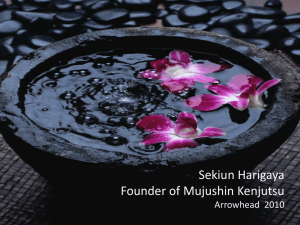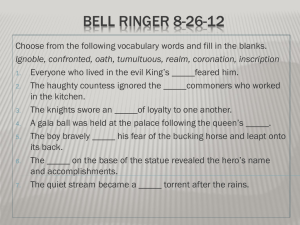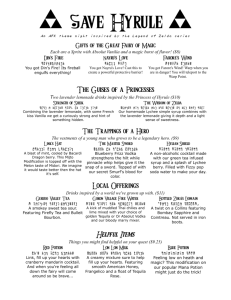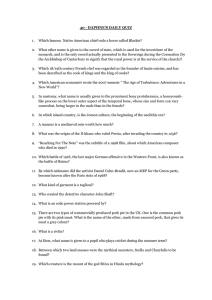Movie 2_Hero
advertisement
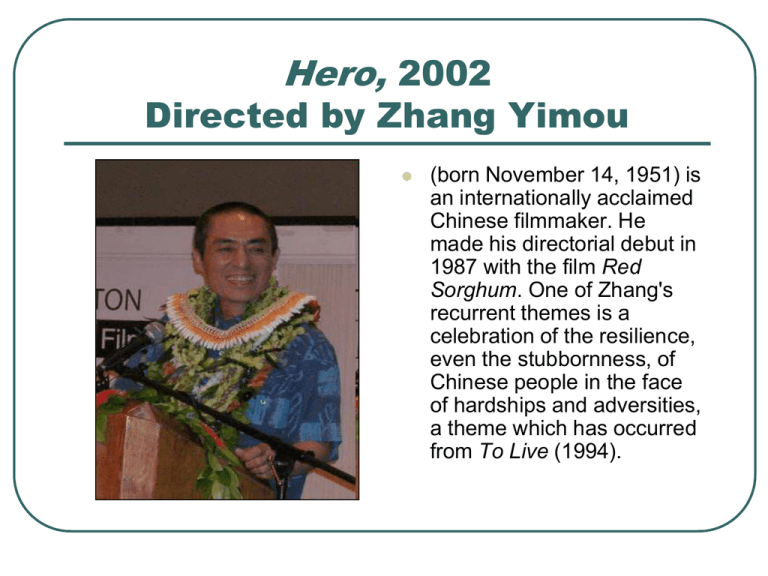
Hero, 2002 Directed by Zhang Yimou (born November 14, 1951) is an internationally acclaimed Chinese filmmaker. He made his directorial debut in 1987 with the film Red Sorghum. One of Zhang's recurrent themes is a celebration of the resilience, even the stubbornness, of Chinese people in the face of hardships and adversities, a theme which has occurred from To Live (1994). Jingke His story is told in the chapter entitled Biography of the Assassins-Retainers (刺客列傳) in Sima Qian's Records of the Grand Historian, or Shiji 86. Out of 5,000 words describing six assassins— Cao Mo, Zhuan Zhu, Yu Rang, Nie Zheng, Gao Jianli--, Jingke’s part counts for about 3,000. 琴棋书画【qīn qí shū huà】 琴【qín】 a general name for certain musical instruments; qin, a sevenstringed plucked instrument in some ways similar to the zither. 棋【qí】 chess or any board game. • 围棋【wéiqí】 a game played with black and • white pieces on a board of 361 crosses; go. 书画【shūhuà】 painting and calligraphy. Jing Ke Described in Shiji 86 Loves reading; Loves swordsmanship; Loves wine Loves singing (Gao Jianli as his best friend) Well behaved; Avoid confrontations; Has his political ideals; Quite a gentleman; But he asked for General Fan’s head so bluntly that some people thought it was very cruel; The Song Winds cry xiao xiao, Yi Waters are cold. Brave men, once gone, Never come back again. See Burton Watson’s translation, 174 “xiao xiao” refers to rustling in the air; bleak; desolate. fēngxiāo 风 萧 yì shuǐ 易 水 xiāo 萧 hán 寒, zhuàng 壮 yí qù 一 去 bú fù 不 复 shì 士 xī 兮 fǎn 返 xī 兮 Scene Titles 1. Nameless 2. Sky 3. Calligraphy 4. Swords and Arrows 5. Jealous Fools 6. Falling Leaves 7. Advance Ten Paces 8. Flying Snow 9. Underestimated 10. Spare the King 11. Our Land 12. Draw Your Sword 13. Execution 14. Credits Multiple Versions ''Hero'' tells and retells one story three times Nameless as a story teller Sky parallels General Fan in The Emperor and the Assassin and offers his sacrifice for a lofty goal; Broken Sword holds the key in leading the whole event towards a dramatic turn; Flying Snow has been living in hatred until she fatally hurt her love Broken Sword; Rashomon Effect (film) Rashomon 羅生門 is a 1950 Japanese crime mystery film directed by Akira Kurosawa. The film is based on two stories by Ryūnosuke Akutagawa — ("Rashomon" provides the setting, while "In a Grove" provides the characters and plot). Who Tells the Truth? The film won the Golden Lion at the Venice Film Festival, and also received an Academy Honorary Award at the 24th Academy Awards. The film depicts the rape of a woman and the apparent murder of her samurai husband, through the widely differing accounts of four witnesses, including the bandit/rapist, the wife, the dead man speaking through a medium (Fumiko Honma), and lastly the narrator, the one witness that seems the most objective and least biased. Flashbacks within Flashbacks The stories are mutually contradictory, leaving the viewer to determine which, if any, is the truth. The story unfolds in flashback as the four characters—the bandit Tajōmaru (Toshirō Mifune), the samurai's wife (Machiko Kyō), the murdered samurai (Masayuki Mori), and the nameless woodcutter (Takashi Shimura)—recount the events of one afternoon in a grove. But it is also a flashback within a flashback, because the accounts of the witnesses are being retold by a woodcutter and a priest (Minoru Chiaki) to a ribald commoner (Kichijiro Ueda) as they wait out a rainstorm in a ruined gatehouse identified by a sign as Rashōmon. Color Scheme Aesthetic vs. Symbolic Cracking the Color Code of 'Hero' -New York Times. August 2004 By Robert Mackey http://www.helloziyi.us/Articles/Hero_Color_Co de.htm Mr. Zhang's plan was to divide "Hero" into five sections, each dominated by a single color. An unlikely collaboration The martial-arts epic "Hero," which opens on Aug. 27, is the product of an unlikely collaboration between two dazzling visual stylists: the Chinese director Zhang Yimou and the Australian cinematographer Christopher Doyle. Switched from Fuji to Kodak It is a Kodak Red, a much more saturated solid red The red color frames the first story, a love story between Broken Sword and Flying Snow The Blue Color frames the second story (between Broken Sword and Nameless) the lack of contrast between characters and setting was intentional The white color frames the third section white against a dramatic backdrop of cliffs that look like old walls falling apart Green is used for all flashbacks Calligraphy and Swordsmanship The essence of calligraphy is from the soul. Swordsmanship is the same. Both aspire to truth and simplicity Gradually I recognized a greater cause. She asked why I had abandoned the mission. I told her the King must not be killed. That is what calligraphy taught me. Yearning for Unification All under Heaven... Our Land swordsmanship's ultimate ideal. It's just dawned on me! This scroll of Broken Sword's isn't about swordsmen’s technique, but about swordsmanship's ultimate ideal. Swordsmanship's first achievement is the unity of man and sword. Once this unity is attained, even a blade of grass can be a weapon. The second achievement is when the sword exists in one's heart but absent from one's hand. One can strike an enemy at 100 paces even with bare hands. The swordsmanship's ultimate achievement is the absence of the sword from both hand and heart. The swordsman is at peace with the rest of the world. He vows not to kill and to bring peace to mankind. Confucius’ Teaching “Harmony is the most valuable” 1.12 The Analects Translated by D. C. Lau Page 7 hé wéi 和 为 guì 贵

